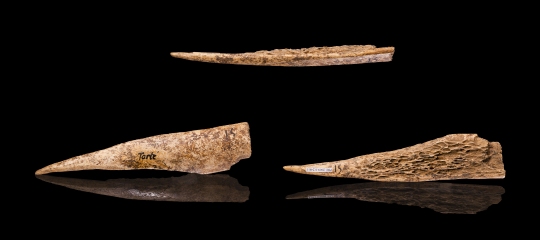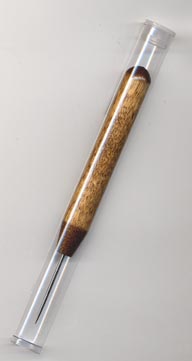Bottles and Windows Quake in My Presence ,
,
Or How to Drill Glass
By Christine Cox
How you drill the glass and the type of bit you use depends on the size of the hole and which type of tool you own. When firing glass in a kiln, the glass gets hot enough to actually flow just a little. This means using a larger drill bit than the finished hole size required. You can use either a diamond core drill bit on a drill press or you can use a special blunt-tipped diamond bit made to work in a Dremel or other rotary tool. I had used both in the past but wanted to study the benefits of each option.

(L) Bit for hand-held rotary tool
(R) Core bit for drill press
After drilling more holes than I want to count, I like the diamond core drill bit on a drill press. It’s a faster and more precise operation than using a Dremel. On the other hand, the rotary tool bit works almost as well and requires only a tool that most of us have around anyway.
Some tips about drilling glass:
Use a Sharpie permanent pen to mark where you want to drill.
It’s important to keep the bit wet and clean during the entire drilling process. It keeps the bit cool, keeps glass dust from going up your nose and it adds a little “slip” to the process. Never drill dry glass. Simply keep water on the piece of glass and occasionally lift the bit out of the hole to allow the glass dust to move out into the water and the water to move into the hole. If a paste starts to form while you are drilling, stop and add water.
When I’m using a Dremel, I keep a little water nearby and use my fingers to splash it onto the top of my glass as I drill. When I’m using a drill press, I like to set the piece of glass I’m drilling onto a rubber mat, then place that into a large flat dish of water on my drill press table. In other words, the glass is actually sitting in a shallow pool of water while I drill.
In both cases (rotary tool or drill press) you want to use a slow speed and a steady hand.

Carole Lamb
Always seat the bit all the way into the chuck. It cuts down on vibration and is safer. Also, it’s better to drill half way through the glass from one side, flip the glass over and then to continue drilling from the other side. This helps prevent chipping the surface of the glass.
The bit for a rotary tool is shaped sort of like an hourglass. Put some water on the glass and start the tool’s motor (slow speed). Hold the tool at about a 15-degree angle and just tap the glass with the edge of the bit to give yourself a little starter dent. Now lift the tool, settle in, get comfortable and brace your arms. Start drilling the hole by moving the tool, at a 15-degree angle, in a slow circular motion. Continue with the same motion and angle until you are about half way through the glass.
Turn the glass over and start again from the other side. I suggest that you dry the glass and mark it again. The parallax caused by the water and also by the beveled glass will visually distort the hole’s placement. The goal is to have the 2 halves of the hole meet in the middle. When you first break through, the hole will be a little misshapen. If you look at the bit you’ll see that its “shoulder” is also encrusted in diamonds. Very gently, with no pressure at all, run the bit all the way through the glass so that the shoulder of the bit can clean out the hole and make it into a neat and tidy round shape.
 To use a diamond core bit in a drill press, the process is similar. Place a shallow dish of water on the drill press stand. Set something into the dish to set the glass on. This should be something that isn’t slippery and that you don’t mind damaging.
To use a diamond core bit in a drill press, the process is similar. Place a shallow dish of water on the drill press stand. Set something into the dish to set the glass on. This should be something that isn’t slippery and that you don’t mind damaging.
Again, seat the bit well into the drill’s chuck. Use a slow speed and a firm hand while drilling. Do not push the drill bit through the glass. Let the bit grind the glass away. The diamond core bit will leave a little cylinder of glass after its work is done. Be sure to remove this from the dish or you may scratch the bevel while drilling subsequent holes. Again, parallax will cause alignment problems so take your time when exiting and re-entering the holes.

Using a Dremel, you rotate the bit at a 15% angle. It’s easier than it sounds.

Water is a lubricant and keeps you from breathing ground glass

My set up for drilling with a drill press

Mark holes with a permanent pen and then be sure to allow for parallax when lining up the bit and the marks
|
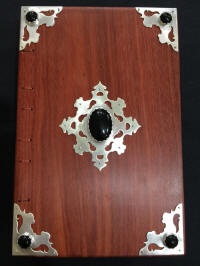
Christine Cox teaches bookbinding and metalsmithing classes (group and private) at her studio in Volcano, CA (halfway between Sacramento and Lake Tahoe)
This article originally appeared in ARTitude Zine and is reprinted with permission. ARTitude is no longer published, which is a great loss for the art world.
|
|


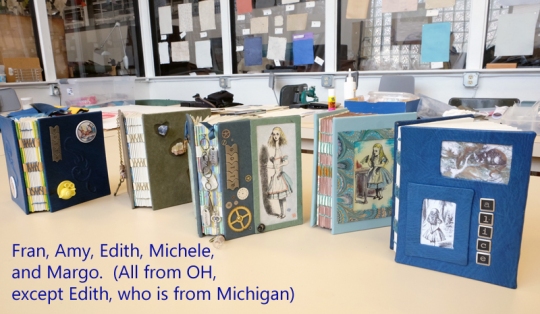



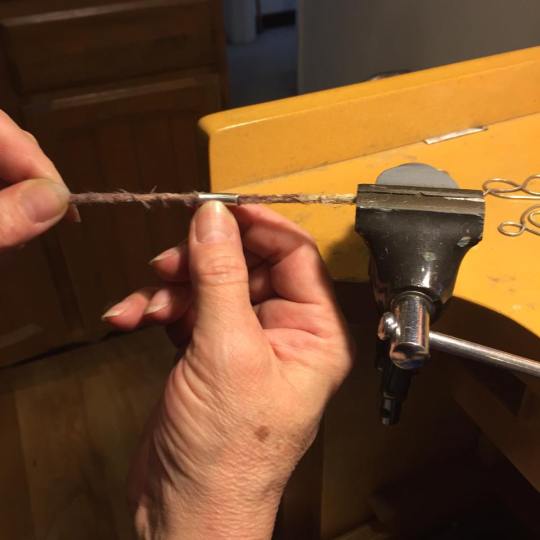
 ,
,

 To use a diamond core bit in a drill press, the process is similar. Place a shallow dish of water on the drill press stand. Set something into the dish to set the glass on. This should be something that isn’t slippery and that you don’t mind damaging.
To use a diamond core bit in a drill press, the process is similar. Place a shallow dish of water on the drill press stand. Set something into the dish to set the glass on. This should be something that isn’t slippery and that you don’t mind damaging.




